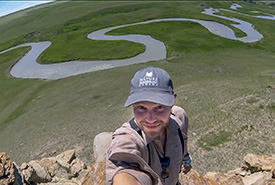Counting crows: A winter walk reveals an abundance of birds in the Fraser River Estuary
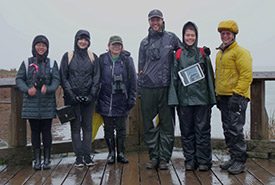
Conservation Volunteers ready for birding (Photo by Fiona Walsh)
For more than a century, an ongoing citizen science survey has taken place during the holiday season. Known as the Christmas Bird Count, the first survey was initiated by ornithologist Frank M. Chapman on Christmas Day in 1900.
One hundred and seventeen years later, Nature Conservancy of Canada (NCC) Conservation Volunteers (CV) in Vancouver joined in the Christmas Bird Count, gathering on the shore of the Fraser River to count birds and contribute their findings to the international survey.
Counting birds for Christmas
We met on a soggy day in December and set out to observe the diversity of species along the Fraser River Estuary, Swishwash Island Nature Sanctuary and adjacent parkland.
We were first greeted by a majestic bald eagle uttering its glorified gull call from its perch atop a fir tree. Many believe the bald eagle's cry is fearsome and powerful; however, this misconception has been perpetuated by years of advertising that dubs a hawk's cry (often a red-tailed hawk) over the audio of an eagle image or video.
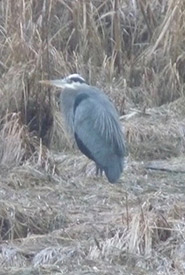
Great blue heron (Photo by Fiona Walsh)
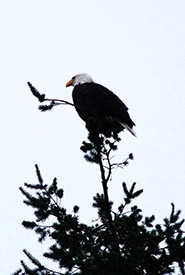
Regal eagle (Photo by Fiona Walsh)
Beneath the eagle's tree, dark-eyed juncos, spotted towhees, black-capped chickadees and a few song sparrows flitted around the shrubs and foraged on the ground. Our group went on to spot a raptor (likely a Cooper’s hawk) streaking overhead. Great blue herons stood like sentinels, while American wigeons waded in the ponds and mallards dabbled in the fields. With each new sighting, we pulled up the species using the iBird app on our mobile tablet. This allowed us to discuss recognizable features and patterns and confirm the species.
As we made our way along the Fraser River, we converged with another small flock of birders. We compared notes and discussed the variety of gulls (glaucous, herring, ring-billed) they had witnessed with their powerful spotting scope. At this point, we saw horned grebes and buffleheads diving in the river, as double-crested cormorants perched on top of posts.
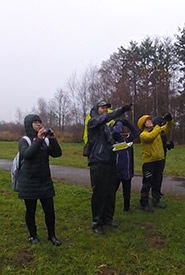
Birders in action (Photo by Rachel Howes)
By noon we had counted 78 birds representing 17 species. The group was gratified, knowing that their morning walk was contributing real data to North America’s longest running citizen science project: the Christmas Bird Count. The Christmas Bird Count is coordinated in Canada by Bird Studies Canada.
Everybody can get into birding
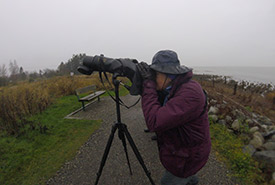
Bird Studies Canada die-hard birder (Photo by NCC)
It’s never been easier to get into ornithology (the scientific study of birds). All it takes is getting motivated to grab your binoculars and head outdoors. Actually, it’s even possible to go birding from the comfort of your home by watching the birds that visit your yard. You can increase the number and diversity of birds by setting up bird feeders or providing suitable habitat, such as native shrubs for cover.
With the Great Backyard Bird Count just around the corner (February 16–19, 2018) this is an ideal opportunity to learn about the birds in your neighbourhood, become a citizen scientist and provide valuable information in a global effort to better understand the health and diversity of birds worldwide!
My favourite birding app

Photo captured from Merlin Bird ID
Merlin Bird ID — I highly recommend this app for anyone new to birding. What makes Merlin so user-friendly is that it walks you through the simple steps of identifying an unknown bird. First, it takes the location from your phone, then confirms the date of sighting. Then all you have to do is select the size of your unknown species from a range of common birds (sparrow, robin, crow or goose), choose up to three primary colours that your bird is sporting, and what behaviour or action it was displaying (swimming, flying, at a feeder, in the trees, etc.).
You will then be given a list of likely species, complete with pictures, information about their habitat, recorded calls and more to help you narrow down your identification.



Photos captured from Merlin Bird ID.
You can explore more than 2,000 bird species from North America and Europe, 650 of which are located in the Canada and the United States. Birders can become familiar with distinctive features — called field marks — to help them recognize and identify newly sighted birds. You can also try comparing a bald eagle call from a red-tailed hawk call.
NCC is planning to host more bird events this year. Check out our CV calendar to find upcoming volunteer opportunities, or our BC events page for Nature Walks and other special events. In the meantime, be sure to check back for more bird blogs.

